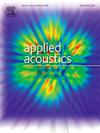Ventilated noise-insulating metamaterials inspired by sonic black holes
IF 3.4
2区 物理与天体物理
Q1 ACOUSTICS
引用次数: 0
Abstract
Sonic black holes represent a special class of metastructures allowing efficient absorption based on the slow sound principle. The decrease in the wave speed in this case is associated with the spatial variation of the acoustic impedance, whereas the absorption properties are linked to thermoviscous losses induced by the local resonances. Typically, sonic black holes are considered as axially symmetric structures consisting of solid rings with a coordinate-dependent radius. This work is dedicated to the development of noise-insulating structures that have a geometry similar to a sonic black hole with a rectangular cross section. Transmission loss in this case is associated with the local coupling between the resonators constituting meta-atoms, which results in the occurrence of broad stop-bands in transmission spectra of the structure. A realistic application scenario of a ventilated duct is considered such that a fan simultaneously generates acoustic noise and air flow. The structure embedded in the duct is shown to demonstrate efficient noise insulation within the spectral range of 1000 – 2850 Hz, while the air flow speed is reduced by just 25%.
受声波黑洞启发的通风隔音超材料
声波黑洞代表了一种特殊的元结构,基于慢声原理允许有效吸收。在这种情况下,波速的下降与声阻抗的空间变化有关,而吸收特性与局部共振引起的热粘性损失有关。通常,声波黑洞被认为是轴对称结构,由半径依赖于坐标的实心环组成。这项工作致力于发展隔音结构,其几何形状类似于具有矩形横截面的声波黑洞。在这种情况下,传输损耗与构成元原子的谐振腔之间的局部耦合有关,这导致结构的透射光谱出现宽的停止带。考虑通风管道的实际应用场景,使风扇同时产生噪声和气流。嵌入管道的结构在1000 - 2850 Hz的频谱范围内显示出有效的隔音效果,而空气流速仅降低了25%。
本文章由计算机程序翻译,如有差异,请以英文原文为准。
求助全文
约1分钟内获得全文
求助全文
来源期刊

Applied Acoustics
物理-声学
CiteScore
7.40
自引率
11.80%
发文量
618
审稿时长
7.5 months
期刊介绍:
Since its launch in 1968, Applied Acoustics has been publishing high quality research papers providing state-of-the-art coverage of research findings for engineers and scientists involved in applications of acoustics in the widest sense.
Applied Acoustics looks not only at recent developments in the understanding of acoustics but also at ways of exploiting that understanding. The Journal aims to encourage the exchange of practical experience through publication and in so doing creates a fund of technological information that can be used for solving related problems. The presentation of information in graphical or tabular form is especially encouraged. If a report of a mathematical development is a necessary part of a paper it is important to ensure that it is there only as an integral part of a practical solution to a problem and is supported by data. Applied Acoustics encourages the exchange of practical experience in the following ways: • Complete Papers • Short Technical Notes • Review Articles; and thereby provides a wealth of technological information that can be used to solve related problems.
Manuscripts that address all fields of applications of acoustics ranging from medicine and NDT to the environment and buildings are welcome.
 求助内容:
求助内容: 应助结果提醒方式:
应助结果提醒方式:


